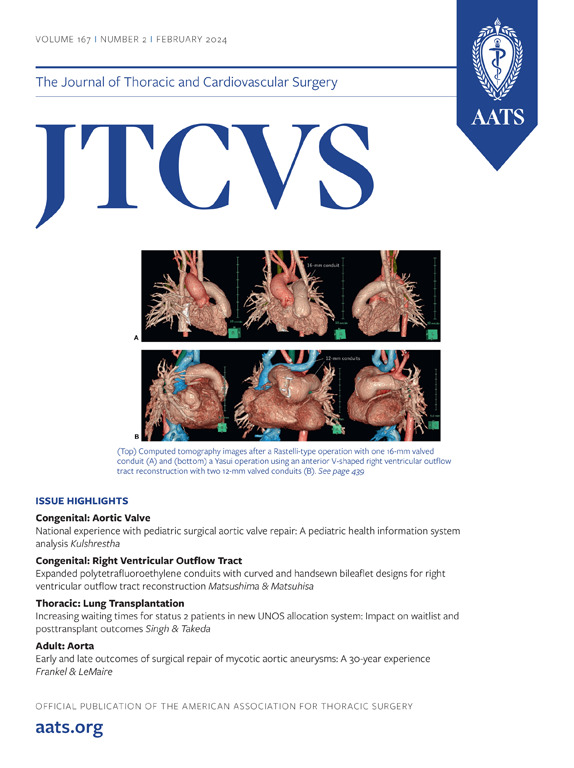Mitral valve repair in the United States: Single-center versus multicenter surgeons’ risk-adjusted outcomes
IF 4.4
1区 医学
Q1 CARDIAC & CARDIOVASCULAR SYSTEMS
Journal of Thoracic and Cardiovascular Surgery
Pub Date : 2025-10-01
DOI:10.1016/j.jtcvs.2025.01.033
引用次数: 0
Abstract
Objectives
Health care consolidation may force cardiac surgeons to operate at multiple centers. Few data exist as to this phenomenon's effect upon patients' quality of care as measured by risk-adjusted outcome (RAO) rates. We sought to compare mitral valve repair (MVr) RAO rates between surgeons operating at multiple centers (MC) versus single-centers (SC); and for MC surgeons, to compare MVr RAO rates between their primary and secondary centers.
Methods
The 2011-2019 Society of Thoracic Surgeons Adult Cardiac Surgery Database's MVr records were analyzed. MC surgeons performed MVr procedures at ≥2 centers within a year; each MC surgeon's greatest MVr volume (“primary”) center was identified. Applying the Society of Thoracic Surgeons−approved 2018 isolated-MVr risk models, study end points included risk-adjusted 30-day major morbidity or mortality (MMM; determined by operative death, dialysis, stroke, prolonged ventilation, mediastinitis, or repeat procedure) and risk-adjusted prolonged length of stay (pLOS). The impacts of surgeon's and hospital's MVr and total cardiac surgery volumes were evaluated.
Results
Compared with MC surgeons, SC surgeons had lower risk-adjusted MMM (odds ratio [OR], 1.170; P < .001). After adjusting for surgeon and center volumes, this finding persisted (OR, 1.141; P = .0155). MC surgeons experienced lower risk-adjusted MMM at their primary versus secondary centers (OR, 1.269; P < .001); this finding was partially attributable to center-based volume variations (OR, 1.130; P = .098). No SC versus MC surgeon risk-adjusted pLOS differences were found; however, regional risk-adjusted pLOS differences persisted.
Conclusions
Compared with SC surgeons, reallocating surgeons’ caseload across multiple centers has a statistically significant, negative impact on their MVr RAO rates.
美国的二尖瓣修复术:单中心与多中心外科医生的风险调整结果(13 个单词,96 个字符)。
背景:医疗保健整合可能迫使心脏外科医生在多个中心进行手术。很少有数据表明这种现象对患者护理质量的影响是通过风险调整结果(RAO)率来衡量的。目的:比较多中心(MC)和单中心(SC)手术的二尖瓣修复(MVr) RAO率;对于MC外科医生来说,比较他们的一级和二级中心的MVr RAO率。方法:分析2011-2019年胸外科学会(STS)成人心脏外科数据库的MVr记录。MC外科医生在一年内在bb20个中心进行了MVr手术;确定每个MC外科医生的最高MVr体积(“主要”)中心。应用sts批准的2018年分离mvr风险模型,研究终点包括风险调整后的30天主要发病率或死亡率(RA-MMM;基于手术死亡、透析、中风、延长通气时间、纵隔炎或重复手术)和延长住院时间(RA-PLOS)。评估了外科医生和医院的MVr和总心脏手术量的影响。结果:与MC外科医生相比,SC外科医生的RA-MMM较低(OR 1.170, p < 0.001)。在调整外科医生和中心容积后,这一发现仍然存在(OR 1.141, p = 0.0155)。结论:与单中心外科医生相比,将外科医生的病例量重新分配到多个中心对其MVr RAO率有统计学上显著的负面影响。
本文章由计算机程序翻译,如有差异,请以英文原文为准。
求助全文
约1分钟内获得全文
求助全文
来源期刊
CiteScore
11.20
自引率
10.00%
发文量
1079
审稿时长
68 days
期刊介绍:
The Journal of Thoracic and Cardiovascular Surgery presents original, peer-reviewed articles on diseases of the heart, great vessels, lungs and thorax with emphasis on surgical interventions. An official publication of The American Association for Thoracic Surgery and The Western Thoracic Surgical Association, the Journal focuses on techniques and developments in acquired cardiac surgery, congenital cardiac repair, thoracic procedures, heart and lung transplantation, mechanical circulatory support and other procedures.

 求助内容:
求助内容: 应助结果提醒方式:
应助结果提醒方式:


